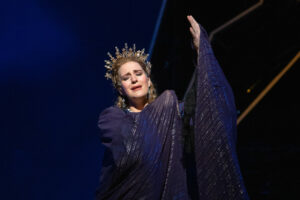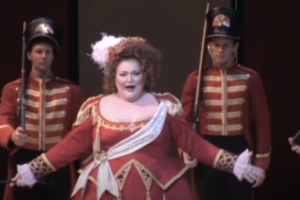

This isn’t the poetry pit stop of Italian opera where whomever yodels on about their current emotional state for a few stanza then rinse and repeat. No, there are a lot of facts and narrative piling up over long stretches and if you get distracted, say filling your wine glass, you can easily find yourself saying 10mins. hence,”Wait, what is she talking about?”
Then there’s the topic of length. In retrospect it’s a good thing that Wagner and Eugene O’Neil managed to miss each other’s artistic maturity by mere decades because they would have no doubt adored each other and ended up collaborateurs. The ensuing musical opus would surely dwarf the Ring and make Long Day’s Journey Into Night appear as an aperitif. The running time of the opera in question, Lohengrin, clocks in just shy of four hours over three acts. Make sure there are provisions handy.
Since its first performance in Weimar in 1850 led by Franz Liszt Wagner’s tale of the Knight of the Holy Grail, and son of Parsifal, led a slow but steady course across the stages of Europe and the Americas. Even reaching Chicago by 1891 starring Emma Eames and the DeReszke brothers. Since Wagner was politically persona non grata at the time in Germany the composer himself didn’t get to see a complete performance of his own work until 1861 in Vienna. The Met annals show a near unending string of performances with barely the break of a year or two even during the second World War. Then great gaps appear in the 1970’s and ‘80’s that continue on today. New York hasn’t seen it in a decade.
This may soon change with the role debuts of two singers that voice fanciers have long hoped would dip a toe into the Wagnerian ocean. In May of last year tenor Piotr Beczala and soprano Anna Netrebko sang in Lohengrin for the first time under the baton of Christian Thielemann in his home house at the Staatskapelle Dresden.
Naturally our friends at Deutsche Grammophon would have been remiss to overlook such a moment (if they themselves didn’t have a hand in orchestrating it) and all the necessary technical apparatus were laid on to make certain we could all enjoy this production on endless repeat forever and ever.
The Saxons, wanting to put their best foot forward for such a starry couple, revived their beloved production from 1983 first directed by Christine Mielitz. The playbook was entrusted to Angela Brandt and she does a fine job making certain no one bumps into each other. Considering the number of people on stage and it’s relatively modest size it’s an accomplishment in itself. I do wonder how much of the directors original ideas and character motives can have survived after over one hundred performances.
The only disappointment is the unit set of the production designer Peter Heilein. The story has been moved from medieval Brabant to Germany during the reign of Kaiser Wilhelm II just before the turn of the century A large interior space with high windows that could be a church or a throne room with a tall gate across the rear separating the nobility from the commoners. It sustains minor adjustments for the opening of Act II with an upper balcony added for Elsa and then, of course, sports a bridal bed for the opening of the last act. Since everything essentially takes place “inside” it’s a production that sadly lacks a single moment of nature. Even the swan is made of glass.
Mr. Heilein’s costumes, however, are glory itself and I’m sure have all been run up fresh for the occasion in magnificently rich fabrics with real velvets and silk organza when high definition cameras are quick to betray cheap substitutions. The many uniforms are especially stunning. They all get the affection from Luca Longarini’s excellent cinematography and really make everyone, down to the riff-raff, look very grand.
I venture to say I can’t imagine the supporting cast being betterred by much. We start out with the strong voiced Herald of Derek Welton. King Heinrich is played by Georg Zeppenfeld with a robust bass with just a touch of gravel on the bottom and a perpetually arched eyebrow that seems the cornerstone of his characterization.
We are indeed fortunate to have the Polish bass-baritone Tomasz Konieczny as the unfortunate Friedrich von Telramund. This is an artist new to me and it seems his repertory is more bass than baritone which is doubly surprising since his singing shows an elegant ease in the higher tessitura of this role. To my ears however he sounds all baritone in this outing. He cuts a handsome figure and plays an excellent foil to his evil sorceress wife. He also proves himself an almost total and unrepentant bastard. One of his best moments comes when the director has him linger in the shadows long enough to witness Ortrud’s evil prayer to the gods. His expression of revulsion only adds to that already powerful moment.
The role of Ortrud herself has a special place in my heart. I think the Met’s Lohengrin telecast might have been my first live Wagner and Leonie Rysanek left an indelible impression on me that has held to this day. The part itself is written so skillfully by the composer already. A comley cobra coiled to strike in Act I, then unleashing a volcano of bile all over the wedding procession in the next. For me the most exciting moment in all of opera is when Ortrud erupts through the crowd in the last moments of the opera gleefully confessing all her malevolence in front of the astonished crowd.
Of course things never turn out as she plans but never has a villain been painted as dark as this. Evelyn Herlitzius never fails to make a meal of every opportunity handed to her here. Whether it’s the cool calculated silence in her first act or her raw fury she remains unstinting in the level of emotion she directs in her malice. Ms. Herlitzius probably never had a conventionally “beautiful” voice but it’s a telling instrument that she marshalls with a canny intelligence and she knows exactly when to throw on an edge. She’s impossible to ignore for a moment and considering the level of her colleagues I have no higher praise.
Which brings us to our heroine Elsa von Brabant and Anna Netrebko. As I powered up my blu-ray player and set my stereo system to “stun,” all I could think of was how was this woman, who I’ve seen rip into Verdi’s Lady Macbeth like it was desert, going to fare as Wagner’s virgin bride? The answer: with the most glorious and perfectly placed legato singing you may every hear in your life. The poise she brings both dramatically and through the voice is astonishing.
So genuine and guileless in the first act she brings an earnestness and complete lack of irony to her prayers for a savior in the first scene. Later, of course, she breathes fire when denouncing Ortrud in the wedding procession and I thought,”Ah, there she is”. Act III finds her mind finally poisoned with doubt, genuinely disturbed at the thought of losing her husband and giving herself to a man she knows nothing of. For me her greatest moment was the happiness that radiated from her at the finale of the first Act. Her honor saved and having literally found her savior.
Never one to coast, Anna proceeds to do a little dominating of the ensemble and lets her voice ring out in those exciting final pages. You suddenly get a glimpse of our Anna enjoying herself as well and there’s real sense of pride coming from her with her accomplishment.
So you’d think none of this could really get much better and you’d be wrong. Piotr Beczala shows up in Act I in a blaze of light riding a rather rickety glass mosaic swan from upstage. They keep him there for his opening,”Mein lieber Schwan” and the audio engineers have the good sense to leave the space on his voice. He sings his opening aria with such a pure, unforced piano I was practically pinching myself.
He makes his mark on this role with his fully supported, lyric heroism. You never hear him push and there’s not a hint of strain. Subsequently there’s never that hectoring quality like so many other tenors when they get Wagner’d-out. Playing a heavenly archetype isn’t difficult either with his relentlessly Dudley-do-right good looks. He proves a tender partner in the great duet of Act III and his ‘In fernem Land’ (the traditional version) proves a wonderful souvenir of his great success in this role.
Maestro Thielemann in the pit is just what everyone needs here. He rarely puts his foot on the gas, but he knows when to, and you’d be surprised watching him how much he gets from the orchestra with a surprising economy of gesture. Not that he doesn’t work up a sweat but he keeps the performance human sized for his lyric-spinto leads. He gets the Dresdeners playing with a velvet incisiveness most especially in the accompanied recit. portions. The prelude is a marvel of sustained control and his architecture leading up to the Act I finale can’t be faulted. He also shows real skill with pacing the orchestral “silences” so crucial to the suspense in the story. Meanwhile I’m trying to think up synonyms for “diaphanous.”
He gets a robust sound from the chorus too and they are able participants in the success of this performance. There’s also a fair amount of blocking and emotional response that’s carried out well. One beautiful touch has the women all turn their backs on Elsa in the last scene by way of dismissing her. As Lohengrin reveals who he is they all turn round again in acceptance.
The lighting design by Friedewalt Degen is very cinematic and favors everyone although the follow spots can get intrusive at times from higher angles.
I have some quibbles with the staging here and there. At the top of Act II Ortrud and Telramund are enjoying a major case of the sulks naturally. During their quarrel he throws her to the ground and kicks her… in the stomach… twice. Wouldn’t he be a little bit afraid of her? The long procession of Act II needs something rather than having the whole town traipse to and fro (I counted three times). But that may be Wagner’s fault rather than the director. This staging also makes Elsa a tad more complicite in the murder of Telramund than usual and while it comes as a surprise I also don’t think it plays as well as it could here.
Sound and picture on my blu-ray were super crisp and subtitles in five languages so you can sing along in Chinese if you want. This was filmed over a number of performance in May of 2016 and I only saw one minor continuity error, so the editing is superior.
Even with the updating of 900 years and geographical change of locale we still have what could be deemed a “traditional” staging here and I don’t think anyone would find this disappointing in the slightest. I can’t recall a live performance where everyone was so evenly matched and giving it their all in such fine fettle. For fans of Mr. Beczala and Ms. Netrebko it’s a must.

























Comments